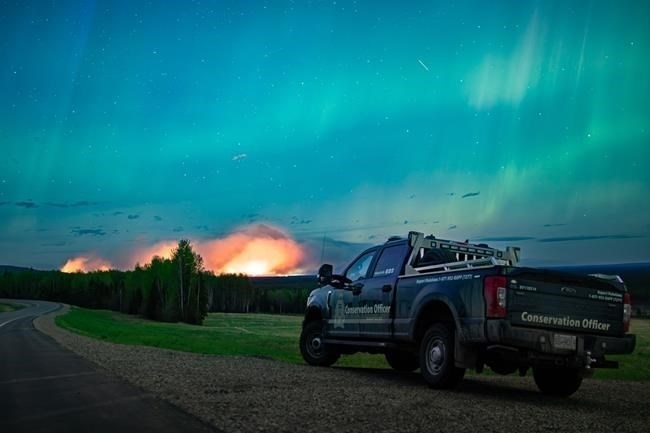
The wildfire forcing thousands to evacuate from a northeast British Columbia town has doubled again in size as the blaze grows merely a few kilometres west of city limits. The Aurora Borealis shines overhead of a B.C. Conservation Officer Service vehicle near the junction of highways 97 and 77, as a wildfire burns in the background near Fort Nelson, B.C., in a Saturday, May 11, 2024, handout photo.
Image Credit: THE CANADIAN PRESS/HO-Ministry of Water, Land and Resource Stewardship
May 14, 2024 - 8:35 AM
A wildfire in the community of Fort Nelson has significantly expanded as residents in British Columbia's northeast receive more mandatory evacuation orders.
The B.C. Wildfire Service says the Fort Nelson fire has grown to over 84 square kilometres since Monday morning, when it was just under 53 square kilometres in size.
Forecasts are calling for windy weather Tuesday that may blow the Parker Lake wildfire toward Fort Nelson, forcing the Northern Rockies Regional Municipality and the Fort Nelson First Nation to expand mandatory evacuation orders to a wider swath of in residents in B.C.'s northeast.
The number of evacuation orders in the province has increased, with the latest one issued by the Peace River Regional District affecting residents around Doig River 206 Monday night.
It's a small community about 60 kilometres northeast of Fort St. John.
The regional district asked residents to grab what they need and go to an evacuation centre in Fort St. John, where help is waiting.
Northern Rockies Regional Municipality Mayor Rob Fraser says the municipality's emergency operations centre called as many people as they had phone numbers for, and managed to convince some of the people who've remained to leave.
Fraser says he suspects about 50 of what he calls "civilians" are still in Fort Nelson, a community of about 4,700 people, but he says there's plenty of other essential and critical staff still in town.
The blaze is one of several burning across Western Canada from B.C. to Manitoba.
A fire in the northwestern part of Manitoba is singeing the community of Cranberry Portage and has forced about 550 residents from their homes, while a fire that's prompted an evacuation alert in Fort McMurray, Alta., appears to be holding about 16 kilometres southeast of the city.
"This is really going to be weather dependent, and so far the weather has been holding with us," Fraser said in a video posted to Facebook on Monday evening, where he explained that winds Sunday night kept the flames from moving any closer into town.
He also said the electricity and water remain on in Fort Nelson, noting that power is of particular concern for evacuees who are worried about their homes.
One drawback of evacuating non-essential people, he said, was that it was becoming challenging for essential staff such as firefighters to get food.
The fire grew to 53 square kilometres in size by Monday, and there is no significant rain in the forecast for northeast B.C. through to next Sunday.
Meanwhile, the Doig River First Nation 60 kilometres northeast of Fort St. John, B.C., has also issued an evacuation order, asking members to leave the area due to a spreading wildfire nearby.
Alberta Wildfire says a blaze that has had 68,000 people in Fort McMurray on notice to be ready to leave at a moment's notice since Friday grew yesterday when the sun came out and the humidity dissipated during the afternoon. Shifting winds also contributed to the growth "in multiple directions," the agency said.
It said on Tuesday, winds are expected from the northwest at 10-15 km/h, shifting to the northeast later in the day, with a high of 19 C.
Another 14-square-kilometre blaze near the hamlet of Teepee Creek in northwestern Alberta was facing extreme wildfire conditions, with gusty winds and no precipitation in the forecast.
Manitoba's wildfire director says in the 40 years he's been working with wildfires, he's never seen one move like the blaze threatening Carberry Portage.
Earl Simmons said the fire was started by lightning and boosted by very dry conditions and strong winds on Saturday, and was growing two kilometres an hour on the head, or the front of the fire.
But with reduced winds, the size of the fire has been holding at more than 300 square kilometres and it has not encroached further toward Cranberry Portage.
This report by The Canadian Press was first published May 14, 2024
News from © The Canadian Press, 2024